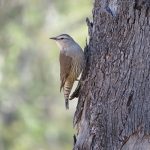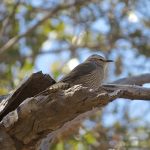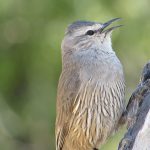BROWN TREECREEPER
The Brown Treecreeper is known for its distinctive behavior and appearance, which are adapted for a primarily arboreal (tree-dwelling) lifestyle. It is a small bird measuring around 15-17 cm in length.
Its plumage is predominantly brown, with darker streaks on the upperparts and a lighter, more mottled pattern on the underparts. They have a long, slender bill, which they use for probing crevices in tree bark in search of insects and other invertebrates. The tail is relatively short and square-tipped.
As their name suggests, Brown Treecreepers are skilled climbers and spend most of their time on tree trunks and branches. They use their sharp bills to pry into bark to find insects and spiders. They also eat nectar and seeds on occasion.
These birds are known for their distinctive creeping behavior, where they move upwards along tree trunks and branches in a spiral pattern, searching for food.
Brown Treecreepers are often seen in family groups or small flocks, and they communicate using a variety of calls.
They are typically found in woodlands, forests, and scrublands with access to suitable trees and tree hollows for nesting.
Brown Treecreepers prefer areas with dense undergrowth, which provides cover and a source of food.
The species is endemic to Australia and can be found in various regions across the eastern and south- eastern parts of the country.
Brown Treecreepers usually nest in tree hollows or other cavities, often reusing the same site for multiple breeding seasons. They lay clutches of eggs, and both parents are involved in incubating the eggs and feeding the young.
Some local populations may be at risk due to habitat loss and fragmentation.
The Brown Treecreeper is a fascinating bird species with unique adaptations for its tree-climbing lifestyle, making it an interesting subject for birdwatchers and researchers in Australia.



